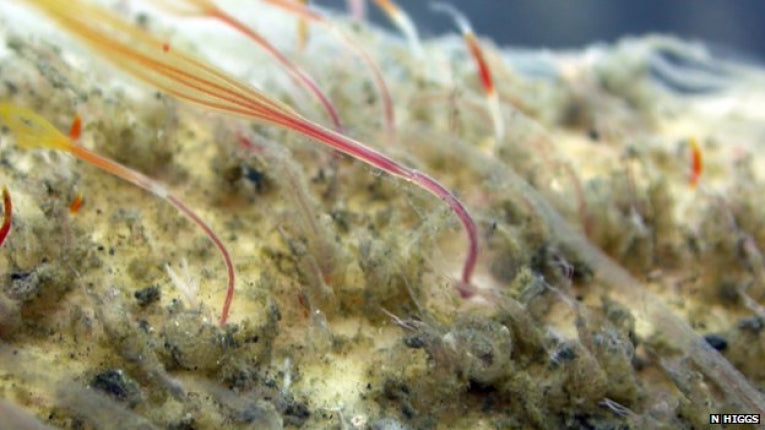If you can keep out of sight, don't mind darkness and leave no trace when you're dead, you too could be a zombie worm. After a few million years, we now have a way to detect the presence of these intriguing animals on fossil whales. Otherwise known as bone worms, they are polychaete worms related to the common ragworm, living on the sea floor, feeding, like a huge and diverse group of saprozoic (creatures feeding on the dead and decaying) organisms, on a single dead whale for up to ten years.
Having lost many of their feeding organs, all these reduced annelids can do is absorb nutrients from whale bones, sans teeth, sans eyes, sans everything! Nicholas Higgs, a Ph D student from the Natural History Museum and Leeds University, found a 3 million year old whale fossil in Italy. "I spent a week there searching through all their collections and I eventually found this bone in a dusty box," Nicholas said. "I study some of the weirdest animals from these habitats, Osedax worms. This specialised group makes a living by boring into and eating the whale bones - and they do this without any mouth, gut or hard parts!"
For the first time, using the Museum's CT scanner, he found it possible to identify the tunnels made by the worms' "roots" within the fossil bone. What Osedax species may have contributed to the destruction of whale fossils over the years has become a terrifying thought to palaeontologists. We could have lost most of our whale fossil record to these tiny zombie worms and it could well account for many missing links.

Nicholas Higgs; Credit: © The Natural History Museum
Unknown in the Mediterranean Sea nowadays, the Osedax polychaetes are common on whale carcasses in all major oceans, usually below 2500 metres and certainly existed at least 30 million years ago. One example is the charming Osedax mucofloris or bone-eating snot-flower worm, a surprise find in a Swedish fjord.

Entire Osedax mucofloris animal, dissected out from a Swedish whale bone, from only 125 metres deep; Credit: © Nicholas Higgs/The Natural History Museum
The dwarf male of the Osedax and the intriguing distribution problem it has are interesting many other scientists. How the fertilised egg or early larva can reach first the plankton and then sink to the depths to feed on the newly dead is a fable we would all enjoy.
The most intriguing question of all to Nicholas Higgs is that if the worms fed on the early whales 35 million years ago, what did they feed on before that evolution? Could it have been the equally enormous giant marine reptiles and if so, could Nicholas find microscopic borings on their fossils? There is so much in the ocean trenches to feed not only zombies, but also our fascination with the unknown and our hyper-imaginative scientists.










